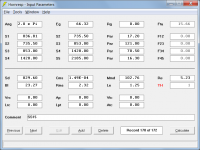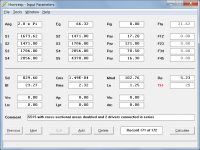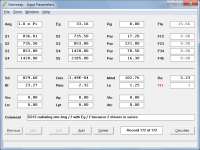If combining two horns in a way that some of the horn volume will be shared, how will it affect the sound?
Below is a sketch to illustrate the problem. Using Hornresp, would the difference between the HD15 and HD215 be that the volume of b, c, and d would double but a would remain the same?

If this is the case, I guess that the tuning of the system will be lowered.
Any help appreciated
Below is a sketch to illustrate the problem. Using Hornresp, would the difference between the HD15 and HD215 be that the volume of b, c, and d would double but a would remain the same?

If this is the case, I guess that the tuning of the system will be lowered.
Any help appreciated
Last edited:
Because of the symmetry of the arrangement, the pressure at any time on the "b" side of the centerline should be exactly the same as the pressure on the "b2" side of the centerline, so there is nothing to drive velocity across the centerline, just as if there had been a rigid piece of plywood preventing flow across the center.
I would model it with lengths equal to the single, areas doubled, and two cones driving.
Marc
I would model it with lengths equal to the single, areas doubled, and two cones driving.
Marc
To simulate the HD215 assuming that the two drivers are connected in parallel:
Either
1. Simulate the HD15, and then use the Multiple Speakers tool to specify two speakers connected in parallel.
Or
2. Simulate the HD15, but with the intended HD215 solid radiation angle halved. For example, if it is planned to use the HD215 in 2 Pi half-space, then simulate the HD15 in 1 Pi quarter-space.
Frequency response and diaphragm displacement results for methods 1 and 2 are identical.
Either
1. Simulate the HD15, and then use the Multiple Speakers tool to specify two speakers connected in parallel.
Or
2. Simulate the HD15, but with the intended HD215 solid radiation angle halved. For example, if it is planned to use the HD215 in 2 Pi half-space, then simulate the HD15 in 1 Pi quarter-space.
Frequency response and diaphragm displacement results for methods 1 and 2 are identical.
I would model it with lengths equal to the single, areas doubled, and two cones driving.
... and also with Vrc, Vtc and Atc doubled.
To simulate the HD215 assuming that the two drivers are connected in parallel:
Either
1. Simulate the HD15, and then use the Multiple Speakers tool to specify two speakers connected in parallel.
Or
2. Simulate the HD15, but with the intended HD215 solid radiation angle halved. For example, if it is planned to use the HD215 in 2 Pi half-space, then simulate the HD15 in 1 Pi quarter-space.
Frequency response and diaphragm displacement results for methods 1 and 2 are identical.
Thank you ! This is really helpful information
Thank you ! This is really helpful information
Attachment 1 shows the input values for your SS15 example.
Attachment 2 shows the input values with SS15 cross-sectional areas doubled and 2 drivers connected in series.
Attachment 3 shows the input values for SS15 radiating into Ang / 2 and with Eg / 2 (because the 2 drivers are connected in series).
The frequency response results for:
* Attachment 1 with the Multiple Speakers tool used to specify 2 speaker in series
* Attachment 2
* Attachment 3
Are all identical, as are the diaphragm displacement results.
Attachments
- Status
- This old topic is closed. If you want to reopen this topic, contact a moderator using the "Report Post" button.
- Home
- Loudspeakers
- Subwoofers
- How to understand shared horn volume ?



